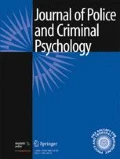Abstract
This study focuses on the functionality of emotion regulation of police officers who have or have not experienced a work-related critical incident. Traumatic events experienced by police officers may have long-lasting and significant consequences, including health concerns, emotional difficulties, impairment in social functioning, and they may have an impact on work performance. The hypotheses outline the expected results to include higher scores for officers who had been involved in one or more critical incidents in emotional well-being concerns and more difficulties with emotion regulation as compared to officers who had not experienced a critical incident. The research design employs written instruments including the General Health Questionnaire-30 to measure general emotional well-being, the Impact of Events Scale to measure the impact of a past traumatic event, and the Difficulties in Emotion Regulation Scale to measure current problems with emotion regulation. Participants consist of 76 full-time police officers assigned to patrol in two police agencies. The findings, analyzed through analysis of variance, did not include significant differences between those groups as expected; however, there were unexpected findings. These findings were that although newer officers were less likely to have experienced one or more work-related critical incidents, they measured higher in measures of emotion regulation difficulties and concerns regarding emotional well-being than did the more tenured officers. The social implications of this study include increased officer and agency awareness and increased use of effective intervention. Implications for future study include the need to further explore emotional challenges that may be experienced by new police officers.
Similar content being viewed by others
References
Augustin D, Fagan TJ (2011) Roles for mental health professionals in critical law enforcement incidents: an overview. Psychosoc Sci 8(3):166–177. doi:10.1037/a0024104
Dyregrov A (1989) Caring for helpers in disaster situations: Psychological debriefing. Disaster Manag 2:25–30
Galatzer-Levy IR, Brown AD, Henn-Haase C, Metzler TJ, Neylan TC, Marmar CR (2013) Positive and negative emotion prospectively predict trajectories of resilience and distress among high-exposure police officers. Emotion 13(3):545–553. doi:10.1037/a0031314
Goldberg D, Williams P (1978) General health questionnaire. NFER-Nelson Publishing, Berkshire
Gratz KL, Roemer L (2004) Multidimensional assessment of emotion regulation and dysregulation: development, factor structure, and initial validation of the difficulties in emotion regulation scale. J Psychopathol Behav Assess 26:41–54
Hyer L, Woods MG, Boudewyns PA (1991) PTSD and alexithymia: importance of emotional clarification in treatment. Psychotherapy 28(1):129–139
Langton, L. (2010). Women in Law Enforcement, 1987-2008. United States Department of Justice, Office of Justice Programs, 1-4. Retrieved from http://www.bjs.gov/content/pub/pdf/wle8708.pdf
Linton JC (1995) Acute stress management with public safety personnel: opportunities for public safety clinical training and pro bono community service. Prof Psychol Res Pract 26(6):566–573
Lundh L, Simonsson-Sarnecki M (1991) Alexithymia, emotion, and somatic complaints. J Pers 69(3):483–510
Menard KS, Arter ML (2013) Police officer alcohol use and trauma symptoms: associations with critical incidents, coping, and social stressors. Int J Stress Manag 20(1):37–56
Mitchell JT (1983) When disaster strikes…The critical incident stress debriefing. J Emerg Med Serv 13(11):49–52
Mitchell JT, Bray GP (1990) Emergency services stress: guidelines for preserving the health and careers of emergency services personnel. Prentice-Hall, Englewood Cliffs
Onnis R, Dadds MR, Bryant RA (2011) Is there a mutual relationship between opposite attentional biases underlying anxiety? Emotion 11(3):582–594. doi:10.1037/a0022019
Ronan WW, Talbert TL, Mullet GM (1977) Prediction of job performance dimensions: police officers. Public Pers Manag 6(3):173–180
Teten AL, Miller LA, Bailey SD, Dunn NJ, Kent TA (2008) Empathic deficits and alexithymia in trauma-related impulse aggression. Behav Sci Law 46:823–832. doi:10.1002/bsl.843
Uomoto JM, Williams RM (2009) Post-acute polytrauma rehabilitation, and integrated care of returning veterans: toward a holistic approach. Rehabil Psychol 54(3):259–269. doi:10.1037/a0016907
Vanhuele S, Desmet M, Meganck R (2007) Alexithymia and interpersonal problems. J Clin Psychol 63(1):109–117. doi:10.1002/jclp.20324
Violanti JM (1997) Residuals of police occupational trauma. Aust J Disaster Trauma Stud 1(3):1–10
Violanti JM, Andrew ME, Burchfiel CM, Dorn J, Hartley T, Miller DB (2006) Posttraumatic stress symptoms and subclinical cardiovascular disease in police officers. Int J Stress Manag 13(4):541–554. doi:10.1037/t00303-000
Weiss DS, Marmar CR (1997) The impact of event scale-revised. In: Wilson JP, Keane TM (eds) Assessing psychological trauma and PTSD: a practitioner’s handbook. Guilford Press, New York, pp 399–411
Woody RH (2006) Family interventions with law enforcement officers. Am J Fam Ther 34(2):95–103. doi:10.1080/01926180500376735
Author information
Authors and Affiliations
Corresponding author
Rights and permissions
About this article
Cite this article
Thornton, M.A., Herndon, J. Emotion Regulation in Police Officers Following Distress: Effects of Tenure and Critical Incidents. J Police Crim Psych 31, 304–309 (2016). https://doi.org/10.1007/s11896-015-9186-1
Published:
Issue Date:
DOI: https://doi.org/10.1007/s11896-015-9186-1


